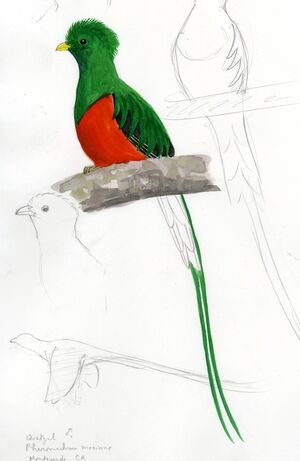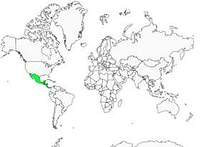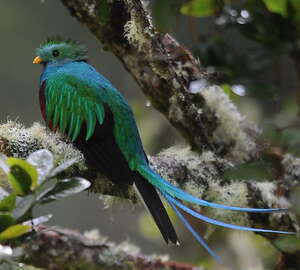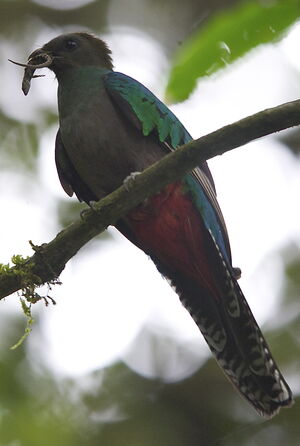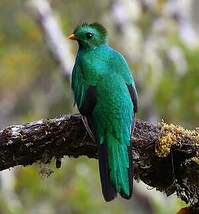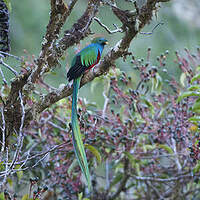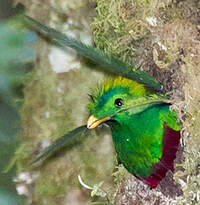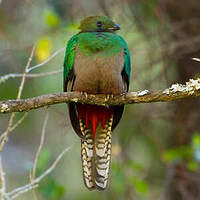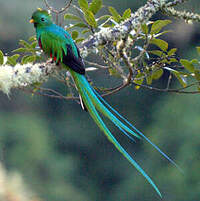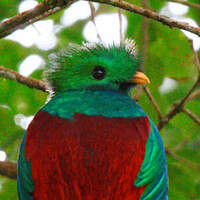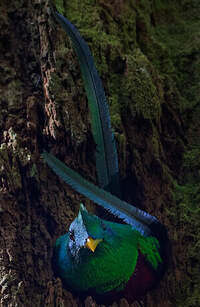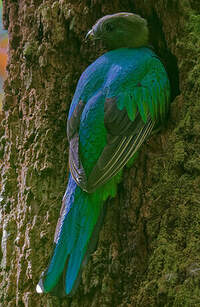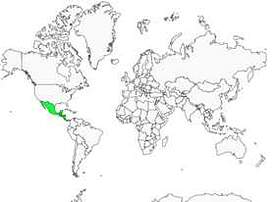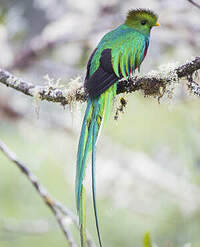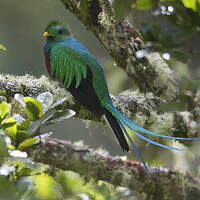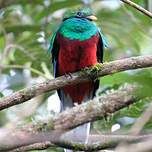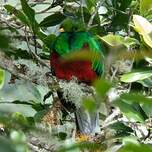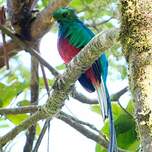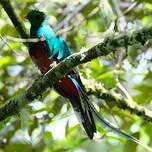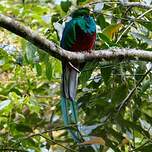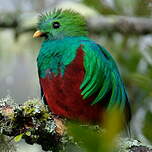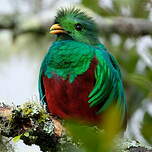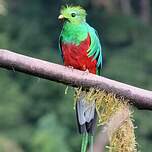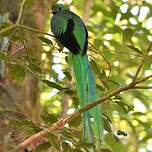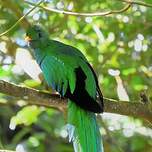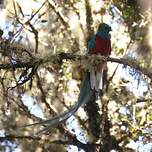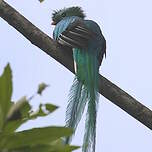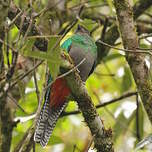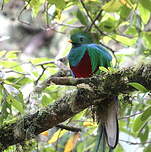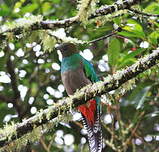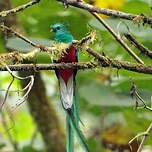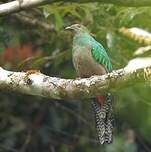Resplendent Quetzal
Pharomachrus mocinno - Quetzal resplendissant
Identification
Pablo de la Llave (1773-1833) described Pharomachrus mocinno in detail in 1832, but it was José Mariano Mocino (1757-1820) who made the first scientific discovery of this incredible bird. Pablo de la Llave named this trogonid Pharomachrus, which means long coat in Greek, honoring his mentor José Mariano Mocino. If the bird is so extraordinary, it's also because its name in Nahuatl (Aztec) can be translated as the amazing green long plume, from which the legend of the feathered serpent Quetzacoalt may come, cohuatl meaning serpent in Nahuatl. While many hypothesis may be possible for Quetzacoalt, there can be no mistake about the Resplendent Quetzal, is it the most beautiful bird in the world or one of the most beautiful existing birds? Pharomachrus mocinno is big, 38 cm without the tail, a tail measuring around 61 cm, that's 1 m from the head to the tip of the tail! Everything is extraordinary with it, the head, the forehead and the beginning of the neck is an electric green, the feathers of its head have a yellow tint that can turn into gold during the reflections of the sun, and they slightly stand up to form an unmistakable crest. The eyes are dark brown almost black, the beak is yellow, the neck, the mantel and the back are emerald green with turquoise reflections, in low light conditions the green tint changes to a blue-green, even a violet blue color. The scapulars and the cover feathers keep the same emerald green color, the Resplendent Quetzal holding its cover feathers almost vertically and separated, the remiges are black, the primaries being long until their rumps. The throat and the upper chest emerald green can turn into turquoise blue with the light. The lower chest, the belly and the bottom of the belly, are scarlet red.One word for the tail: extraordinary! The lower rectrices are white and present in three distinct pairs bordered in black when the bird is seen from the front, four green rectrices finish off the tail, with the two central ones being very long, measuring up to sixty centimeters from the uppertail coverts, the two outer ones being always green but shorter. When the bird is viewed from behind, one can distinguish the three pairs of upper rectrices which are black and masked by the two outer green pairs. The gray tarsi can barely be seen. Much to the chagrin of the ladies, this description pertains to the male, his wife being more discreet. The first observation is that the tail is almost normal! A brown-green head, a cap, throat, and nape; a black eye and bill, the upper chest is still brown-green but striped alternately with brown and green, the stripes are quite diffuse and seem more or less marked depending on the individual. The belly is brown-gray with a somewhat "faded" tone, the lower belly is red, though also with a duller shade than the male's. The green coverts are shorter and not as long, the primary feathers are black with very visible white edgings. The lower rectrices are horizontally striped with white and black, these stripes seem to differ from one female to another, with some appearing whiter or the opposite. The upper rectrices are black and present the two central normal-sized green pairs, much shorter than the male's. The juveniles look like their mother, the immature males have shorter coverts and do not have their father's tail, their lower rectrices divide into three white pairs at the tips which are gray-black, the borders are striped black and white, and the tip of the tail is black. In fact, the immature male is very close to a classic trogon.Two subspecies are recognized, mocinno previously described in southern Mexico, Guatemala, El Salvador, Nicaragua and central and northern Nicaragua, ssp costaricensis smaller, Costa Rica, northwest Panama, central rectrices shorter and closer, the green color is more yellowish.
Subspecific information 2 subspecies
- Pharomachrus mocinno mocinno (s Mexico to n Nicaragua)
- Pharomachrus mocinno costaricensis (Costa Rica to w Panama)
Foreign names
- Quetzal resplendissant,
- Quetzal guatemalteco,
- quetzal-resplandecente ,
- Quetzal,
- kvézál,
- Quetzal,
- Quetzal risplendente,
- praktquetzal,
- Praktketsal,
- kvesal chochlatý,
- kvesal chocholatý,
- Quetzal,
- mayaketsaali,
- quetzal esplèndid,
- kwezal herbowy,
- Квезаль,
- カザリキヌバネドリ,
- 凤尾绿咬鹃,
- praktquetzal,
- 鳳尾綠咬鵑,
Voice song and call
You often hear them emit a koy-koy-koy-koy that changes to a rapid kwah-kwah-kwah at regular intervals, resembling the bark of a puppy. They sometimes form small flocks of 5-6 individuals and give a sharp aiy-aiy-aiy which can be used as an alarm or warning call. When they are together, the male and female Resplendent Quetzal emit a monotone wee-wee-wee in the presence of an intruder or danger.
Habitat
He loves the altitude, and can usually be found from 1,200m upwards, very rarely lower. In Mexico in the North of Chiapas he travels between 900 and 2350m, and in Northern Guatemala he can reach heights of more than 3,000m.
Behaviour character trait
The Resplendent Quetzal is not a long-distance migratory species, but instead follows seasonal changes in vegetation.
After the breeding period at high altitudes within the tropical forests, it descends to follow the fruiting cycles of the Lauraceae. In 1989, seven birds were fitted with radio transmitters in the Monteverde Reserve of Costa Rica, and at the end of the breeding period between February and June, the Quetzals were observed to have moved towards the Pacific coast in mid-altitude forests, between 1300 and 1450m. They stayed there until October-November, then crossed the Central American Cordillera to the Caribbean coast, between 700 and 1200m, where they stayed until January before returning to the high tropical forest for the start of the cycle. In Mexico, in the far south of Chiapas, they descended to the limits of the coffee plantations in May-June and almost no individuals were found in August at high altitudes.Dietfeeding habits
Their diet is primarily frugivorous; Lauraceae is the nourishing thread of the Resplendent Quetzal: Ocotea, Nectandra, Phoebe, Persea americana (which gives us avocados).
It has often been observed picking fruits in competition with toucanets, who chase Quetzals away from trees. Our Resplendent Quetzal has great importance in the dispersion of seeds and therefore the renewal of the Lauraceae of the tropical forest, aside from fruits they will be opportunistic and become, at times, insectivorous. Beetles, orthopterans, all the larvae, as well as snails or lizards. The carnivorous diet is more pronounced during and for the feeding of young, who have an exclusively insectivorous diet in the first 10 days.Reproduction nesting
The Resplendent Quetzal reproduces from March to April in Mexico, in the Chiapas can reproduce in July, May-June in El Salvador, March to May in Guatemala and from March to June in Costa Rica, where they can have two broods.
The nest is made inside a branch excavation of a tree, with a minimum height of 4 to 5 meters, but their average is about 15 meters in Costa Rica, some nests have been seen up to 25 meters in the high tropical forest. The entrance of the nest has a diameter of around 10 cm and the chamber 25 to 30 cm; it is thought that the Resplendent Quetzal could use old nests of big woodpeckers. The male "warns" nearby individuals of his presence with a vertical flight up to the canopy and suddenly coming down to land on a branch, and at the same time giving a brief wac-wac..wac-wac" call. The couple fiercely defends the nest, with the female becoming very aggressive if she senses danger. Two eggs are deposited on a layer of old bark and small wood pieces, the incubation time is 17 to 18 days and both parents take turns. The growth of the young ones lasts 23 to 31 days and unfortunately, the mortality rate is high, 80% of the young ones die in the nest and another 80% of the remaining would not reach adulthood. This high mortality rate is mainly due to predation and the weather. The nest is located in decomposing and dead trees, which expose it to harsh weather conditions (rain, wind, etc.).Geographic range
Threats - protection
IUCN conservation status
concern
in the Wild
threatened
evaluated
Near Threatened, translated as nearly threatened! Should any comments be added? In 1940, American ornithologist Dr. Alexander Skutch (1904-2004) wrote: The male bird is absolutely stunning, all things considered, as I had never seen before. Its beauty comes from the intensity and striking contrast of its colors, the resplendent shine and sparkle of its plumage, its elegant ornamentation, the symmetry of its shapes, and its noble bearing... Will Alexander Skutch's words be able to curb the evils of our civilization? In front of us lies an extraordinary bird; let us make sure not to exterminate it.
Sources of information
- IOC World Bird List (v14.2), Gill, F and D Donsker (Eds). 2024-04-18.
- Birds of Mexico Central America, Ber Van Perlo
- A Natural history of the Trogonidae, Joseph M.Forshaw Albert Earl Gilbert
- The Birds of Panama, George R.Anger Robert Dean
- Vol. 6 - Handbook of the Birds of the World, Josep del Hoyo-Andrew Elliott-Jordi Sargatal
- xeno-canto, Sharing bird sounds from around the world,
- Avibase, Lepage Denis
- BirdLife International, BirdLife International
- ARKive, Christopher Parsons
- Arthur Grosset's Birds, Arthur Grosset
- All About Birds, Cornell Lab of Ornithology
- Wikipédia, Wikipedia, The Free Encyclopedia
- Planet of Birds,
- THE AVIANWEB, Sibylle Faye
- Whatbird,
Other sources of interest
 Specification sheet created on
29/07/2023 by Anne et Gabriel Leboff
Specification sheet created on
29/07/2023 by Anne et Gabriel LeboffTranslation by AI Oiseaux.net
© 1996-2025 Oiseaux.net
- Accipitriformes
- Aegotheliformes
- Anseriformes
- Apodiformes
- Apterygiformes
- Bucerotiformes
- Caprimulgiformes
- Cariamiformes
- Casuariiformes
- Charadriiformes
- Ciconiiformes
- Coliiformes
- Columbiformes
- Coraciiformes
- Cuculiformes
- Eurypygiformes
- Falconiformes
- Galliformes
- Gaviiformes
- Gruiformes
- Leptosomiformes
- Mesitornithiformes
- Musophagiformes
- Nyctibiiformes
- Opisthocomiformes
- Otidiformes
- Passeriformes
- Pelecaniformes
- Phaethontiformes
- Phoenicopteriformes
- Piciformes
- Podargiformes
- Podicipediformes
- Procellariiformes
- Psittaciformes
- Pterocliformes
- Rheiformes
- Sphenisciformes
- Steatornithiformes
- Strigiformes
- Struthioniformes
- Suliformes
- Tinamiformes
- Trogoniformes

